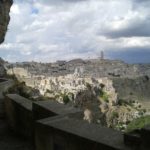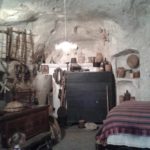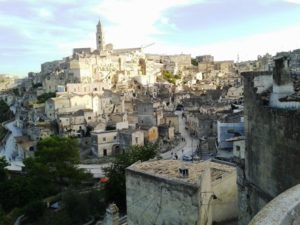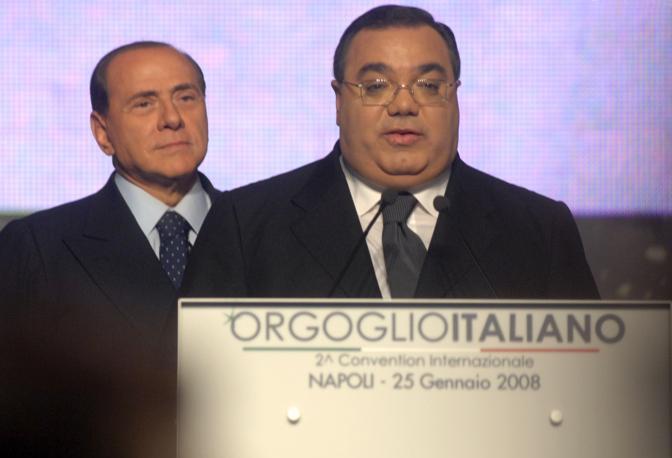You’ll see no Rome, Florence, Venice or Taormina in this diary. Instead, I’ll take you to small unknown places of rare beauty often harbouring next to territorial or industrial diseases, ‘ugliness’ of various kind that makes Italy the cradle of the best and the worst. I was taken to these places in the long hot Italian summer by chance or simply by getting lost, always the best way to travel for the non-‘holiday-package’ traveller.
This is not an itinerary, a tourist guide or a suggested tour. I just happen to be in those places and I want to share my sensations and the ideas they evoked in me with you. To make you feel these spots the way I felt them. Even in the frenzy of XXI century life, this is an attempt to recollect emotions in tranquillity through my inward eye.
Matera, the unbelievable ‘city of stones’ (Sept. 2017)
When the bus dropped me off in the Matera new town centre, I thought I had arrived in another example of the savage concrete bonanza, sprung out of corruption and mafia power, that degraded whole boroughs of two artistic jewels like Naples and Palermo in the 60s. But as you reach the limits of the ancient town, an astonishing landscape awaits you. The hill in front of you, made of a white soft rock called tufo, has been transformed into a village built physically into the rock, hence the name of città dei sassi, city of stones.
The first impression is shocking because you have never seen a place like this. In prehistoric times, caves were carved out of the mountains, real cliff dwellings that reminded me of the Native American ones I saw at Bryce Canyon in Utah. Then the so-called rupestrian civilization, with its houses and churches dug into the rock and its external camminamenti – walking paths – emerged at the turn of the first millennium. In the Renaissance and Baroque periods, new external parts and facades were added to the rupestrian houses and palaces for the nobility and many churches were built too.

Today you see the houses coming out of the rock and you don’t understand what’s going on until you visit one. The town looks like a Christmas presepio, a landscape naturally Turneresque, a view certainly sublime. Next to the town is a canyon with a river running at the bottom, the Gravina, and on the other side another hill, now a belvedere, that adds natural wild beauty to the overall scene with a stroke of picturesque.
Here the Middle Ages lasted up to the 1950s, literally. Matera was one of the poorest village in Southern Italy in the poorest Italian region, Basilicata, a God-forgotten area of rare natural beauty, a coast to coast mountainous territory less infested by the mafia than the other neighbouring regions, for the simple reason of the lack of lucrative business. You can visit some peasants’ traditional cliff houses, case rupestri: they lived with no water, no electricity, no toilet, in just one big room, with the animals inside the house. All they possessed was a donkey and a cart to go to the field to work. And to try and keep children from dying of starvation, they made them eat dried poppies’ leaves so the kids slept for a few days. Matera came to be known to the world in 1945 when anti-fascist writer Carlo Levi wrote Cristo si è fermato a Eboli, a shocking reportage of the area’s lifestyle and conditions. The Middle Ages ended when the government took notice in the 50s and forced the inhabitants to move to new houses built in the new parts of town. Thanks to the social commitment of the post-war governments, the new boroughs were an outstanding example of new town blocks respectful of the landscape. It did not last long: soon concretization and corruption shaped the modern town the way you see it now when you arrive.
After the relocation programme, heritage began, and the process of moving from dust to stardust started too. The movies had its part in the course: Pier Paolo Pasolini shot Il Vangelo secondo Matteo here in the 60s: what better location could he find as an objective correlative to his vision of Jesus and the apostles as peasants, working-class heroes? Since then, filmmakers started to use Matera as setting on a regular basis. Soon Hollywood came along too: Mel Gibson’s The Passion of Christ, shot in 2004, has Matera as Bethlehem. Since then, Hollywood visits the town regularly. Besides, the town became a UNESCO site in 1993. As a consequence, tourists started to flow in and redesigning began.
That was a dangerous moment, the risk of having MacDonald’s restaurants inside the ancient rupestrian houses, motels and hotel chains nearby and, consequently, German tourists with white socks and sandals and American ones with their baseball caps and shorts roaming among the ancient street was high. Luckily, the authorities, the Sovrintendenza ai Beni Culturali, did their job well and the modernization/conservation process was carried on wisely. Today the town is almost completely renewed but maintained. Inside the sassi there are lots of B&Bs, hotels, restaurants, bars, shops, but the heritage is safe: behind modern comfort, you still have a glimpse of the way it used to be by sleeping in the original rooms and by eating the original way – exquisite and healthy delizie from the peasants’ tradition. Accordingly, tourists from all over the world and tourist operators adjusted to the style: for example, there are no sightseeing big buses, only old-fashioned ape cars from the 50s take them around. Cultural events and shows too are held here more and more frequently: Matera is the 2019 European City of Culture and the town is putting on its make up for the event.
Include Matera in your Italian tour and you won’t regret it: stroll in the sassi, visit the old houses and churches, follow the path down the canyon, eat some local delizie, have a drink in the wine bars inside the caves, watch the skyline at night. Hidden Italy will surprise you once again.














 The book "Silvio Berlusconi's Italy" is
The book "Silvio Berlusconi's Italy" is 
Leave A Response